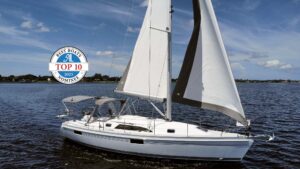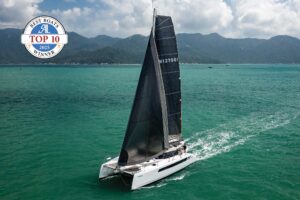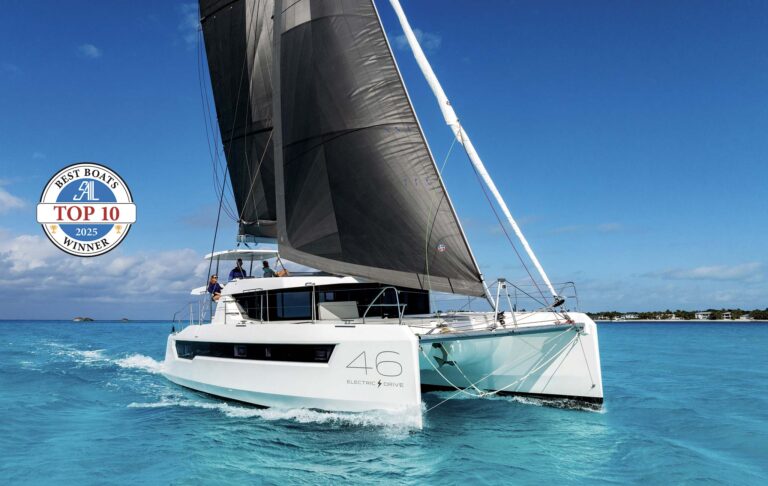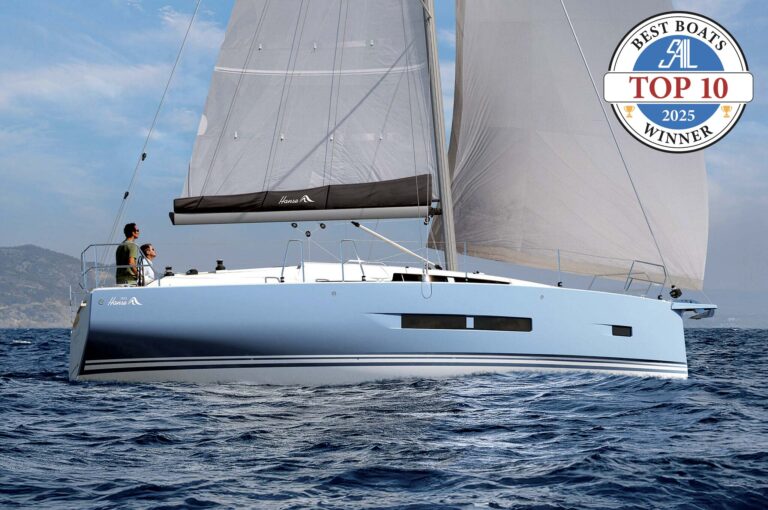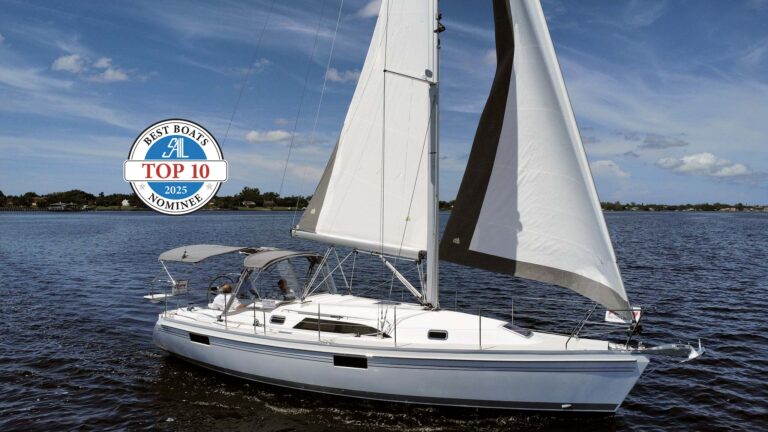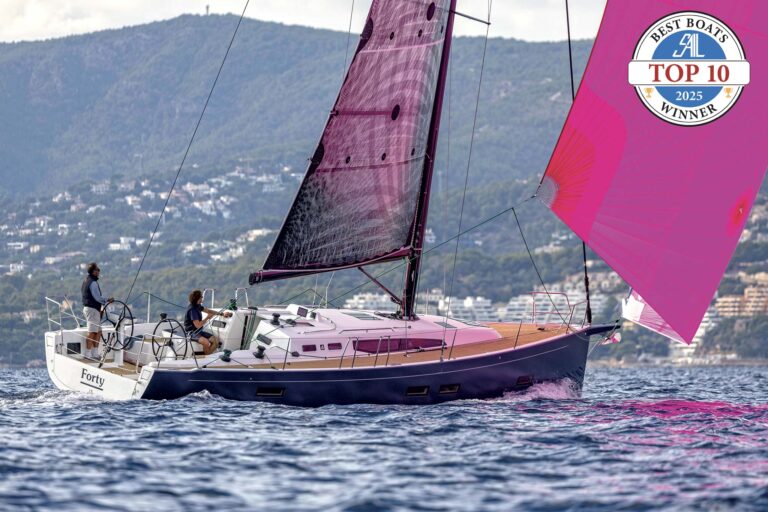
French catamaran builder Lagoon, created an unimaginable following when it launched its 380 nearly two decades ago. With over 800 of the boats built to date, it appealed both in size and price to couples with cruising dreams. No model launched since has been successful in pushing the queen off her pedestal. But that may change with Lagoon’s newest introduction, the Lagoon 40.
Design & Construction
The Lagoon 40 replaces the previous 39 and the 400 models. Designed by VPLP, the new cat adopted the styling of her larger siblings, including more angular transoms, longer rectangular hull ports to let light stream in below and a coachroof that flows into an upward-angled composite hardtop, which gives the boat an aggressive look. The wraparound windows are still vertical, but their elongated look gives this 40-footer a recognizable profile. Extra attention was paid to keeping the weight low, with vacuum-infusion construction and balsa coring in the deck and the hull above the waterline. The mast is positioned well aft in an effort to make the main that much smaller and easier to handle for shorthanded crews.
On Deck
The changes on deck were made mostly at the aft end, where the transoms have been squared off, and there are also now two shallow steps that lead up from the swim platforms to the cockpit. A transom seat was added in the cockpit itself and the dining table to port was turned 90 degrees. This results in a more open flow so that numerous diners can gather round while others still move about freely.
To starboard, a set of steps leads directly to the helm, a nicely integrated station where the driver can be a part of the conversation in the cockpit even while standing watch. Visibility is good aft to the twin transoms when you duck under the hardtop. However, you can’t see both bows from the wheel unless you use the built-in step on the interior bulkhead where you manage winches. Unfortunately, from that vantage point, the engine throttles are hard to reach, so while docking you are faced with the choice of either seeing the bows or having a good handle on the propulsion.
The helm is open to the starboard side deck, making it a snap for the driver to lend a hand with dock lines or assist with anchoring. You can also climb up onto the hardtop either from here or via a flip-up ladder attached to the forward cabintop. This ladder is a simple solution if you need to quickly access the mast from the foredeck. However, with wet feet on a bouncing vessel, it is a challenge to use it.
An athwartships sunpad with lifting headrests was added to the foredeck, just abaft the trampoline. The cushions also lie over the two cavernous lockers that hold the windlass and water tanks. Two small opening ports integrated into the forward window make it possible to pass a drink to anyone lounging on the foredeck, saving a trip out back to the cockpit and around. Another nice feature is the option to upgrade the water tankage by doubling the standard 79 gallons.

Accommodations
Interior changes to the Lagoon 40 haven’t been dramatic, but the tweaks add a feel of luxury. With the upgraded interior package, in particular, the 39’s stark aesthetic of white fiberglass or gray/beige cabinetry is gone, replaced with richer shades of dark brown Alpi wood and plenty of leather accents.
The saloon and galley layout on the main deck remain pretty much as before. Most of the galley, including an Eno three-burner stove, an under-counter front-loading refrigerator and ample cookware stowage, is still in the aft port corner. To starboard is an additional Isotherm refrigerator/freezer and plenty of overhead provisions lockers. A small nav desk is tucked into the forward port corner and includes room for a multi-function display and other instruments. Everything is at hand, and the traffic flow works, especially if there are fewer guests.
The Lagoon 40 is available with three to four cabins and two to four heads. With the entire port hull dedicated to the master suite, the owners’ version is quite posh. Forward is the head with a large shower stall, while aft is a berth that’s cut away on one side so it’s easier to climb up at bedtime. Amidships, owners will be able to relax at a desk and accompanying settee. The sliding door that provides privacy also has a built-in bookcase on the inside. Both ends of the cabin are well lit by overhead hatches, opening ports and long fixed hull windows.
To starboard are two guest cabins that share a head with a large shower stall. For charter, two equal hull layouts with two heads are available. For the truly ambitious, four heads can be wedged in so that each cabin on charter has its own bath. However, that’s a lot to pack into 40ft, and I can’t see the need for this configuration in most circumstances.
Under Sail
The key to sailing the Lagoon 40 is the 706ft Code 0. With romping fun conditions outside Government Cut just off South Beach in Miami, we unfurled the large headsail and soon found ourselves touching 10 knots of boatspeed in 16-18 knots of true wind on a beam reach. As we hardened up to 50 degrees and the true wind dropped to 15 knots, we still held onto 7.9 knots. The important thing to note here is that this cat will keep her speed even at a 50-degree apparent wind angle, making her more than just a downwind cruiser.
Upwind sail area is 875ft with a self-tacking jib that makes her easy to handle. A square-top mainsail is an option and provides even more horsepower for sailing to windward.
With an air draft of 60ft 5in, the Lagoon 40 is ICW-friendly, and with her agility, pound-for-pound and foot-for-foot, she actually seems to out-sail larger cats in her class. Her compact helm also makes for easy shorthanded sailing. We became so enthralled by our spirited ride back inside the cut, we lost track of time and even our way for just a moment.
Under Power
Our test boat was equipped with twin 45hp Yanmar diesels (the standard is 29hp) with saildrives and Flexofold folding propellers. In lumpy seas, we slipped along at 7.5 knots at 2,400 rpm. To satisfy industry standards, the engine room hatches now hinge aft so you can inspect the diesels underway without stepping out onto the transoms. It’s nice to see engine rooms of adequate size so you don’t have to origami yourself into ridiculous shapes to conduct routine maintenance.
Conclusion
Only time will tell if this will be the magic model that will finally retire the 380, which now is in limited production—only about 30 hulls annually. With its updated accommodations and a good turn of speed, the new Lagoon 40 is certainly a viable candidate. Even if she doesn’t displace the beloved 38-footer, she should still be on every cruising couple’s short list as a modern example of what a small cat can be.

Specifications
LOA 38ft 6in
LWL 38ft 6in
Beam 22ft 2in
Draft 4ft 5in
Displacement 24,000lb (lightship)
Sail Area 875ft
Air draft 60ft 5in
Fuel/Water (GAL) 106/79
ENGINES 2x 29hp Yanmar diesels
SA/D Ratio 17 D/L Ratio 188
What do the ratios mean? Click here
Designer Van Peteghem Lauriot Prevost (VPLP)
Builder/U.S. Distributor Lagoon America, Annapolis, MD
Price $322,000 (base) at time of publication
MHS Summer 2018


